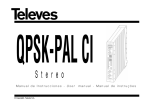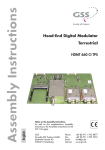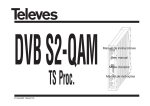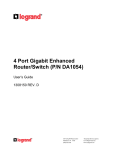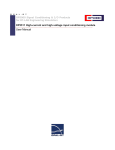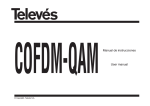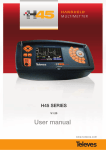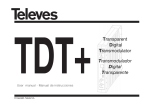Download Ref. 5630
Transcript
Ref. 5630 EN TWIN DVBS2-QAM User manual w w w. t e l e v e s . c o m TWIN DVBS2-QAM Index 4. 5. 6. 7. 8. 9. Technical specifications ...................................................................................................................... Reference description ......................................................................................................................... Mounting ............................................................................................................................................. 3.1. Wall mounting .............................................................................................................................. 3.2. 19” rack mounting ...................................................................................................................... Element description ............................................................................................................................ 4.1. Introduction .............................................................................................................................. 4.2. TWIN DVBS2-QAM ................................................................................................................... 4.3. Power supply unit ..................................................................................................................... 4.4. Amplifier .................................................................................................................................. 4.5. Universal programmer ............................................................................................................. How to use the product ...................................................................................................................... 5.1. Main menu ............................................................................................................................... 5.2. Extended menu ......................................................................................................................... 5.3. Parameters saving .................................................................................................................... 5.4. Status LEDs .............................................................................................................................. Controlling the device ........................................................................................................................ Distribution of 42 QAM channels ........................................................................................................ Norms for rack mounting .................................................................................................................... Norms for cabinet mounting ............................................................................................................... 5 7 8 8 9 10 10 12 13 14 15 16 16 19 20 21 21 23 24 26 EN ENGLISH 1. 2. 3. 5 1. Technical specifications 1.1. TWIN DVBS2-QAM Satellite Demodulator QAM Modulator UP-Converter General ref. 5630 Input Frequency: 950 - 2150 MHz Modulation: DVB-S2 (QPSK, 8PSK) DVB-S (QPSK) Input Level: 49 to 84 dBμV (-60 to -25 dBm) Symbol Rate: 2 to 42.5 Mbaud (DVB-S) 10-30 Mbaud (DVB-S2) Frequency Steps: Input and Output connectors: Input Impedance: 1 MHz FEC Input: LDPC (9/10, 8/9, 5/6, 4/5, 3/4, 2/3, 3/5, 1/2) “F” female FEC Output: BCH (Bose-Chaudhuri-Hocquenghem) 75 ohm. Roll-off Factor: 20%, 25%, 35% LNB Power Supply: 13/17V/ OFF 22KHz (ON/OFF) Return losses: 10 dB min. Throughput Losses: < 1,5 dB typ. Modulation Format: 16, 32, 64, 128, 256 QAM Scrambling: DVB ET300429 Symbol Rate: 6,9 Mbaud max Interleaving: DVB ET300429 Roll-off Factor: 15% Bandwidth: 8 MHz max. Block Code: Reed Solomon (188, 204) Spectral inversion: Normal / Inverted (Select.) Output Frequency: 46- 862 MHz (Select.) Through losses: < 1,5 dB typ. Frequency Steps: 250 KHz Return losses: > 12 dB typ. Phase Noise: 90 dBc/Hz @10KHz typ Input and Output connectors: “F” female. Output Level: 80 ±5 dBμV Output Impedance: 75 ohm. Adjustable Output Level: >15 dB Spurious level: 55 dBc min. >60 dBc typ. Power Supply: 24V Index of Protection: IP20 Consumption 24V: 550 mA typ. (without powering LNB) 800 mA typ. (powering LNB) The technical characteristics described are defined for a maximum ambient temperature of 45°C (113ºF). Forced ventilation is used for higher temperatures. EN TWIN DVBS2-QAM 6 1.2. Technical specs. Broaband Amplifiers Amplifier 5575 Amplifier 451202 (1) Main channel Frequency range: 46 ... 862 MHz Connector: “F” Gain: 44 ± 2,5 dB Powering voltage: 24 V Regulation margin: 20 dB Consumption at 24 V Output level (60 dB): 105 dBμV (42 CH CENELEC) Test socket: : -30 dB 450 mA Frequency range (1): 47 ... 862 MHz Connector: “F” Gain (1): 40 - 53 dB (selec.) Mains voltage: 196 - 264 V~ 50/60 Hz Maximum output level (1): 129 dBμV (typ.) (DIN 45004B) Max. Power: 16 W Frequency range (2): 5 ... 30 MHz Test socket: -20 dB Gain (2): 20/ -3 dB (typ.) Maximum output level (2): 129/ --- dBμV (typ.) (DIN 45004B) (2) Return channel (active/passive) 1.3. Technical specs. Power Supply Unit Power supply 5629 Mains voltage: 196 - 264 V~ 50/60 Hz Total max. current (outpur 1 + output 2): 5 A (24V ) Output voltage: 24V Max voltage per output: 4 A (24V ) 1.4. Blocks Diagram DVB-S DVB-S2 Demodulator TS processing QAM modulator (A module) INPUT SAT DVB-S DVB-S2 Demodulator Up Converter TS processing QAM modulator Up Converter (B module) OUTPUT DVB-C 7 2. Description of references Product Range Accessories 5630 T-0X TWIN DVBS2-QAM 7234 Universal Programmer 5575 Broadband Amplifier 44dB 120dBμV T-0X 5071 T03-T05-T-0X Mounting rail (50 cm) 451202 Amplifier DTKom (47 - 862 MHz) 5239 T03-T05-T-0X Mounting rail.12 Modules+PSU (56 cm) 5559 Headend Manager CDC-IP T-0X 5301 19” Subrack frame 555901 Headend Manager CDC-IP GSM T-0X 507202 T-0X Lockable cabinet with Ventilation Unit (7 Modules + PSU) 5629 Power supply unit 24VDC/5A T-0X 4061 75 Ohm DC-Block load 4058 75 Ohm Load 422601 T05 to T-0X Power connection lead (40 cm) 422602 T05 to T-0X Management connection lead (40 cm) 422603 T-0X Management connection lead (1m) 5673 Blank plate 50 mm EN TWIN DVBS2-QAM 8 3. Mounting 3.1. Wall mounting 5629 IF satellite input 5630 5575 BROADBAND AMPLIFIER DVBS 2-QAM TWIN DVBS 2-QAM TWIN TEST (-30dB) 5071 5239 UAMP44 UQQA-S2-T UQQA-S2-T DVBS 2-QAM TWIN UQQA-S2-T DVBS 2-QAM TWIN UQQA-S2-T UQQA-S2-T UQQA-S2-T DVBS 2-QAM TWIN DVBS 2-QAM TWIN CLAC! PRGM PRGM PRGM 1 QAM output 4061 A B C 7234 NOTE: The use of both PSU power outputs is recommended to balance the consumption. For example, 4+3 or 3+4 2 9 3.2. 19” rack mounting BROADBAND AMPLIFIER DVBS2-QAM TWIN CTRL PWR CTRL TEST (-30dB) PWR UAMP44 CTRL PWR UQQA-S2-T DVBS2-QAM TWIN DVBS2-QAM TWIN CTRL PWR UQQA-S2-T CTRL PWR UQQA-S2-T DVBS2-QAM TWIN DVBS2-QAM TWIN CTRL PWR UQQA-S2-T UQQA-S2-T PWR UQQA-S2-T DVBS2-QAM TWIN EN 5301 PRGM PRGM PRGM PRGM PRGM PRGM UPSU120 02340037001 003 02340037001 003 02340037001 003 02340037001 003 02340037001 003 02340037001 003 02340038001 002 TWIN DVBS2-QAM 4. Identification of the system elements 4.1. Introduction The DVB project has brought about an evolution in DVB-S satellite transmission standards in order to improve its characteristics, with the objective of increasing satellite transponder capacity and flexibility in transporting different types of data beyond the MPEG transport stream. To do this, new coding schemes and more complex modulation schemes are used (8PSK). For error protection, it has progressed from the DVB-S Viterbi and Reed Solomon scheme to more complex algorithms (LDPC and BCH). Furthermore, DVB has established the QAM modulation format as one of the digital signal distribution formats in SMATV networks, characterised by its robustness against noise and adjustment errors as well as its high spectral efficiency. According to this standard, TV signals via satellite are distributed across SMATV networks using transparent transmodulators, which convert the satellite modulation format to QAM. Furthermore, it is also possible to carry out transmodulation of terrestrial digital television signals (COFDM) to QAM. The unification of the modulation format to QAM for signal distribution allows the user to utilize a unique, receiver for all signal types, independently of their original modulation format (DVB-S, DVB-S2 or COFDM). 10 “Stuffing” In many cases, QAM receivers include software that performs frequency band searching with only one symbol rate as a variable, for example 6.875 or 6.9 Mbaud, which is the maximum binary rate that can be sent over an 8 MHz channel for QAM modulation. Therefore, transmodulation devices that are installed in the headend must operate at this symbol rate, independently of the input signal’s binary rate. To achieve these QAM signal characteristics, MPEG2 transport packet stuffing should be performed in the headend. Furthermore, COFDM terrestrial signals vary in binary rate from one country to another according to the transmission parameters (e.g. for Spain are: 8 MHz bandwidth, 64QAM, FEC 2/3 and guard interval 1/4). The same occurs with satellite signals. So this is why, when transmodulating signals from COFDM or QPSK to QAM, different output binary rates are obtained, for example: QPSK satellite (27.5 Mbaud FEC 3/4) => 64QAM 6.875 Mbaud COFDM terrestrial (64QAM FEC 2/3 IG 1/4) => 64QAM 3.600 Mbaud This complicates automatic searching or “scanning”: the receiver should detect all QAM distribution signals by searching the entire band, using both frequency and binary rate as searching parameters. This process can be very slow. Automatic searching is easier if all QAM signals are identical (same modulation format and symbol rate). As a result, stuffing techniques are applied to demodulated data prior to their subsequent QAM modulations. Service Elimination In some cases, especially with DVBS2 input signals, the satellite input rate may be too high to be transmitted in a QAM output signal. It is necessary to select which of the services available at the input will be distributed at the output, eliminating unwanted services and thus reducing the binary rate. PID_filtering At the same time, for certain distributions such as small CATV, the network operator may decide to eliminate certain services (PID_filtering) in order to avoid paying royalties to the service provider. The DVB-S2 to QAM transmodulator allows the selection of available services at the input for elimination at the output. This fact causes that some scanned void services are identify by the receiver as N.A. (for example). 11 Operator_id PRODUCT DESCRIPTION For certain cable networks, it is important to replace the operator_id field received in the input transport stream with a value corresponding to the cable network operator. This action is managed by the CDC software, version 2.14 or higher. The TWIN DVBS2 to QAM unit consists of two transmodulator modules sharing the same chassis, referred to as modules A and B. Each module receives a satellite transponder signal at its input (in one of its modulation formats defined by the DVB-S2 standard: QPSK or 8PSK) and demodulates it to obtain a MPEG2 transport packet. The transport packet is then modulated in QAM format and sent to the output channel (UHF or VHF and maximum bandwidth of 8 MHz) using an agile upconverter. Each transmodulator module A and B has its own upconverter, allowing the TWIN DVBS2-QAM unit to send the two output signals completely independents, and thus achieving better use of distribution bandwidth. One of the unit’s applications is for separating an input transponder’s signal in DVBS2 format (whose direct transmodulation would exceed the maximum normally allowed channel bandwidth) into two QAM output channels, maintaining all transponder services. The two input transponders should have the same bandwidth and polarity since the input to both modules A and B is shared. The universal programmer (ref. 7234) is used to program the operating parameters of the two A and B modules inside the TWIN DVBS2-QAM unit (mainly input and output frequencies and modulation formats). NIT Handling To facilitate the receiver’s search for all available QAM signals on the SMATV network, a mechanism for processing the NIT table (NIT Handling) has been implemented. It consists of generating a NIT table that contains all the information from different QAM channels present on the network (frequency, modulation order, baud rate). Each transmodulation module, DVBS2-QAM or COFDMQAM, substitutes the NIT table at the input for this new table. This way, the receiver only needs to tune in to a QAM channel in order to access this data, greatly facilitating the search for services currently on the network. The user manages this NIT Handling mechanism via the CDC program version 2.14 or higher. The TWIN DVBS2-QAM unit includes an IF loopthrough for the input connectors on the top of its front, in order to enable the passage of the input signal to other modules. On the other hand, allows current by-pass through the IF input cable (13 or 17 Vdc) to power the LNB. In the event of a shortcircuit at the input connector, the front LED starts flashing, stopping once mended the shortcircuit to restore the 13/17V voltage at the input connector. EN Also, the LED colour indicates the unit’s status: - Green: correct operation of both modules A and B. - Orange: correct operation with low input C/N in one of the modules. - Red: anomalous operation in one of the modules A and/or B. Likewise, it has an RF input and output connector, in order to mix the channels for sub-sequent amplification. TWIN DVBS2-QAM 12 UQQA-S2-T 1 2 DVBS2-QAM TWIN 4.2. DVB S2-QAM Twin 3 4 PWR CTRL PRGM 5 7 8 6 1. IF satellite input 2. IF satellite output 3. RF input 4. RF output 5. Powering BUS connectors 6. Status LED 7. Control BUS connectors 8. Programmer / PC socket 13 4.3. Power supply unit (1) UQQA-S2-T DVBS2-QAM TWIN Connectors to power the modules (1) GND EN PWR CTRL On LED 24V 24V 0V 24V 0V 24V 24V: OK 0V: Overload or short circuit UPSU120 Mains input 230V~ NOTES: - The power source can supply a maximum of seven TWIN DVBS2-QAM modules. - Whenever the demand of power exceeds 4A (max. current for each output), it is necessary to distribute it between the two powering outputs of the PSU. TWIN DVBS2-QAM 14 4.4. Broadband amplifier OPTION “A” - 5575 TEST (-30dB) PWR 6 +10 dB 5 UAMP44 BROADBAND AMPLIFIER 1 2 OPTION “B” - 451202 20 dB On 20 dB 10 dB OK - MATV 10 dB 20 dB MATV OK - Return USO EXCLUSIVO EN INTERIOR FOR INDOOR USE ONLY C. Ret C. Ret ¡¡¡ATENCIÓN!!! NO ABRIR. TENSIONES ELEVADAS DENTRO ¡¡¡WARNING!!! DO NOT OPEN. LIVE PARTS INSIDE I. max 150mA 196-264V~ 50/60Hz Fuse: T1A L 250V 02340019 002 MATV Ret. OUT Test IN -20 dB Test OUT -20 dB Ret. IN 7 3 4 1 1. RF output 2. Test socket (-30 dB) 3. RF input 4. RF input 5. Powering BUS connectors 6. Status LED 7. Gain attenuator It features two input connectors, to allow mixing of channels coming out from two different systems. If only one of the inputs is used, it is recommended to load the unused input with a 75 ohm terminator, ref 4061. As the rest of T-0X units, this amplifier is powered via the 24 Vdc power BUS. 2 3 4 5 1. Mains input (196-264 V~ 50/60 Hz) 2. Ground connection 3. Power LED 4. MATV input Return channel output 5. MATV input test 6. MATV output test 7. MATV output Return channel input Input signals through connectors 3 & 4 are combined and amplified in the frequency band 47-862 MHz 6 7 MATV 15 4.5. Universal Programmer The programmer features 4 buttons: (short press) - Selection of parameter (positioning of the cursor). PCT 4.0 - UNIVER Modification of the parameter chosen by the cursor (flashing) SAL (short press) - Change menu (long press) - Change between Principal and Extended menus A B C (long press) - Save changes to memory + Cloning menu. + + Increases the contrast of the screen. + + Decreases the contrast of the screen. EN TWIN DVBS2-QAM 16 5. - Instructions for Use 5.1. Main Menu Connect the controller to the front socket of the module (“PRGM”). At first, the controller’s firmware version will appear: To switch between A and B modules of the TWIN unit, keep pressed the key until the A/B indication stars to flash in the upper left corner of the display. Then use keys and to select de desired module. Within B module, changes of parameters are updated after saving. Only changes in level are updated instantly. Within A module, all changes of parameters are updated instantly. Cloning functions are available by pressing keys and . These functions allow copying the TWIN DVBS2QAM unit configuration into the programmer and then download it to another TWIN DVBS2-QAM unit. Please refer to Universal Programmer’s leaflet to check all these cloning functions. PCT firmware version -----------X.XX The firmware version of the TWIN DVBS2-QAM unit is shown below: Unit firmware version: V:X.XX To modify the frequency, press until the cursor shifts over the desired digit. Then change its value using keys and . The range of allowed input frequency values is 950-2150 MHz, whereas the range for symbol rate is 10 to 30 Mbaud for DVB-S2 signals and 2 to 42.5 Mbaud for DVB-S signals. b. QAM Modulation Menu The following main menu displays the selected QAM modulation parameters: AQAM Mod: 64QAM IQ:normal Baud:6.900Mb a. Input Menu The first main menu allows selection of input frequency, the modulation standard (DVB-S or DVB-S2) and the symbol rate. AINPUT Freq:1234MHz Mod: DVBS2 Baud: 27.500 The available options for the QAM modulation stage are: 16QAM, 32QAM, 64QAM, 128QAM and 256QAM. The IQ parameter is the modulation format selection and can be set to “normal” or “inversion”. The user must select the QAM output baud rate. The maximum value for QAM output baud rate is 6.9Mbaud. Due to the different modulation capacity, depending on the satellite signal’s baud rate, 17 it may not be possible to transmit all input transponder content in the QAM output. The user must therefore select which services pass through to the output and which are to be eliminated (see Service Menu). using keys and . As output frequency decimal, only the following values can be selected: c. Output Menu To change the output level and output mode, press until the cursor is over the desired field, which is modified using keys and . The following main menu shows output frequency, output level control and output mode control. AOUTPUT Freq: 474.00 Level: 00 Output:Norm. The output frequency range is 47-862 MHz. The output level control can be set between 00 and 99. The available output values are: • Norm Normal Output Mode • CW Continuous Wave Mode. A carrier is generated in the frequency selected (useful for balancing the headend in the absence of an input signal). • OFF No output generated. • NULL Output with null packets only. To modify the frequency, press key until the cursor is over the selected digit. Changes are made => .00 MHz => .25 MHz => .50 MHz => .75 MHz d. Service Menu This menu shows the list of transport stream services selected. Each time the user selects a new input transport stream, the unit performs a search for services. During the process, the unit will show the message below displaying the number of channels as soon as they are being found: ASERVICE Scanning:003 Once the search has completed, a list of services is displayed with the following information: ASERVICE * 7/13 04/11 PLANETE NO LIMIT ON The service order number as well as the total number of services in the multiplex (the figure indicates that the 7nd service out of 13 services, is available), the statistics (18/25), the name of the service and if the user has selected it to: be removed from the output (OFF), or to pass through without modification (ON). After the scanning, the services will be marked OFF or ON according to the selection made in the Configuration Menu 2 (5.2 Extended Menu, section b). Whenever a service is considered as new, it will be indicate with an asterisc “ ” on the upper right corner. The statistics are displayed as follows: N / M, where: N: percentage of total input bitrate occupied by the current service. M: percentage of input bitrate that exceeds the available output bitrate of modulation (overflow). Users should aim to prevent overflow by using service elimination. Note: These are mean values. If the bitrate is adjusted in such a way that the final bitrate of the all services not eliminated is similiar to the available output bitrate, it EN TWIN DVBS2-QAM may cause occasional overflows and then be necessary to eliminate another service. This is due to the temporal variability of bitrate services. The possible indications for these measurements are: When statistical measurements are not yet available: --/??: Even when the overflow value is not yet available, a time stamp (PCR) adaptation error is detected that may cause adaptation problems at the output. This state is called “Critical adaptation”. --/01: Even when the overflow value is not yet available, an excess rate is detected at the input. The MEASUREMENTS menu displays the message: “Eliminate services”. --/--: The calculations have not yet been completed and there is still no rate overflow. When statistical measurements are available: N/??: A time stamp error is detected (PCR), so even though the input bitrate can be adapted to the output, it may produce flickering in the decoded image. The message displayed will be: “Critical Adaptation”, and will always be displayed before any indication of memory overflow due to excess bitrate (“Eliminate Services”). 18 N/M: N: is the percentage of input binary rate occupying the corresponding service. M: is the percentage of input rate that doesn’t “fit” in the output rate. If it isn’t 00, an overflow is produced due to excess rate at the input and the message displayed will be “Eliminate services”. If M is 00 there is no overflow. It is the correct operational condition. --/M: When we have a service that is displayed in this way, even though statistical calculations have been completed, it means there is no information about its input transport occupancy. Its ON/OFF status makes no difference for the adaptation. These measurements allow the user to select the services for elimination in such a way as to best utilize the available baud rate at the output. For example, if for a particular service, the percentage of occupancy is greater than that of overflow (e.g. 08/04) it will be sufficient to eliminate that service (OFF) so that overflow does not occur at the output. On the other hand, if the occupancy percentage is less (e.g. 13/40) it will be necessary to eliminate more services for correct operation when the input signal is DVBS2. To ensure correct operation, the user will have to verify in the Measurements Menu 2 that the Percentage of Occupancy of the available bitrate at the output is shown, instead of some other error message. Percentages of occupancy greater than 82% are not recommended, due to the fact that for input channels with high bitrate variability, overflows may occur. e. Measurements Menu 1 This menu shows the estimates for C/N (dB) and link margin (dB). AMONITOR >> C/N: 4.5dB L.M.: 4.3dB This is a read-only menu, and the keys and allow selecting the module (A or B) to be monitored. f. Measurements Menu 2 This menu shows messages related to adaptation and service elimination, as explained in the service menu. If the module is unplugged, no message will be displayed. The possible messages that may appear in this menu are as follows: - Eliminate Services: It is necessary to eliminate more services since overflow is being produced at the output. - Calculating...: Measurements of occupancy and/ or overflow are not yet available. 19 - Impossible to Calculate: The number of input signal services is greater than the device’s supported capacity, due to memory limitations. It is not possible to estimate a reliable statistic. - Critical Adaptation: even though the input rate is not yet higher than output rate, an overflow in the time-stamped internal memory is detected, which has a high probability of producing an overflow rate. With this alarm activated, the output channel does not cut out, but may produce flickers in the image. - Occupancy: arises when adaptation is being carried out without errors and shows the user the occupying Bit Rate percentage at the output. Occupancy values greater than 82% are not recommended when the input signal is DVBS2. AMONITOR Occupancy: 75% g. Selection of operator_id 5.2. Extended Menu This menu allows the selection of the “operator_id” field that will be replaced in the output transport stream. Whenever there is no input transport stream, the display will read: “No operator_ID detected”. When the key is held down for more than 3 seconds the unit displays a series of menus that are used less frequently, called extended menus. The parameters that are configured in this menu affect both modules A and B. Aop_id Select the operator_id OX1239 EN a. Configuration Menu 1 This menu allows the selection of the unit’s address (for controlling via a Headend Manager System CDC), as well as the power supply of the LNB converter. CONFIG )) Adr CDC: 123 LNB:13V22KHz ATTENTION: In order to control the headend remotely, each device should be assigned a unique address (1 to 254). It is the responsibility of the installation personnel to ensure that there are no duplicated addresses in the control bus. To make a change, press until the desired digit flashes. Next, this digit can then be changed using the keys and . TWIN DVBS2-QAM b. Configuration Menu 2 This menu allows to set ON or OFF the status of the new services. New services are those found after the first scanning, e.g. due to changes in the input TS. A given service no longer be new once the user saves the new configuration. Whenever a service is considered as new, it will be indicate with an asterisc “ ” in the Service Menu. CONFIG New services ON 20 The recommended operational margins are as follows: • Optimum Operation : 0-6 • High Temperature: 7-8 The following menu indicates the unit’s current temperature as well as the maximum recorded. It is possible to reset the maximum by pressing . TEMPERATURE Now: 04 Max: 05 reset This final extended menu allows the selection of menu languages (Spanish / English / German): • Excessive Temperature: 9-10 If the maximum recorded is outside the optimum margin, the installation should be modified in an attempt to reduce the temperature, for example by mounting the modules within a T-0X cabinet with ventilation ref. 507202. d. Version Menu c. Temperature Measurement Menu e. Language Menu This menu displays the firmware versions for the unit and the transport stream process module (FPGA). VERSIONS Unit: 1.00 FPGA:2.03 LANGUAGE English Pressing keys language. and changes the selected 21 5.3. Saving Parameters Once the desired value has been selected in any of the menus (normal or extended), in order to record the information, hold down the key for approximately 3 seconds. The screen will display the following: Saving settings and restarting ... Do not remove the programmer until the message disappears. If configuration data is modified but not recorded, the previous configuration is restored after 30 seconds have elapsed, i.e. the new changes are discarded. 5.4. Status LEDs Finally, the LEDS indicate the following operational status: - Left Led (A) = C/N of input signal sufficient (for guidance). - Central Led (B) = DVB-S /DVB-S2 demodulator hooked. - Right Led (C) = QAM modulator hooked. LEDs ON indicate correct operation. If one of them goes out, it indicates that something is working wrong. This situation is displayed on the frontal LED of the unit, that will change its green colour (no events) by the red one: there can be happening any one of the events indicated by the LEDs of the programmer in any of both A and B modules. If using one of the normal menus, the LEDs indicate the status of module A or B that is being displayed, whereas in the extended menus they indicate the status of both modules (only a certain LED will illuminate if the LEDS of both modules A and B are illuminated). 6. - Controlling the Device This version of the TWIN DVBS2-QAM allows configuration and monitoring via a PC, both locally and remotely. a. Local control The “Headend Management” programme (v2.14 or higher) is required, as well as a special cable (provided with the programme) that connects a PC serial port to the TWIN DVBS2-QAM “PRGM” socket. The programme can be used to set up and read all the operating parameters, as well as to monitor the correct operation of the device. b. Remote control It is necessary to have a Headend Control module (ref. 5559 or 555901) that includes the programme mentioned above, and the corresponding modem connected to a phone line. Once the communication with the headend control has been established, all the controllable devices that have been installed in the headend can be accessed. In this case it is essential that each element be programmed with a different device address between 1 and 254. EN TWIN DVBS2-QAM 22 Menus structure AINPUT Freq:1234MHz Mod: DVBS2 Baud: 27.500 CONFIG Adr CDC: 123 AQAM Mod: 64QAM IQ:inversion Baud:6.900Mb TEMPERATURE Now: 04 Max: 05 reset LNB:13V22KHz Long press AOUTPUT Freq: 474.00 Level: 00 Output:Norm. AVERSIONS Unit: 1.00 FPGA:2.03 ASERVICE 7/13 04/11 PLANETE NO LIMIT ON LANGUAGE English AMONITOR >> C/N: 4.5dB L.M.: 4.3dB AMONITOR Occupancy: 75% Aop_id Select the operator_id OX1239 At any moment, modules A and B can be switched by pressing keys and when the cursor is over the A/B indication situated on the upper left corner. 23 7. Application example Distribution of 42 QAM channels VH DVBS2-QAM TWIN DVBS2-QAM TWIN DVBS2-QAM TWIN DVBS2-QAM TWIN DVBS2-QAM TWIN DVBS2-QAM TWIN 75 ohm 4061 DVBS2-QAM TWIN DVBS2-QAM TWIN DVBS2-QAM TWIN DVBS2-QAM TWIN DVBS2-QAM TWIN DVBS2-QAM TWIN DVBS2-QAM TWIN DVBS2-QAM TWIN HH Quattro 5629 7 x 5630 (14 canales) 5629 7 x 5630 (14 canales) DVBS2-QAM TWIN DVBS2-QAM TWIN DVBS2-QAM TWIN DVBS2-QAM TWIN DVBS2-QAM TWIN DVBS2-QAM TWIN HL DVBS2-QAM TWIN VL 5151 451202 5629 7 x 5630 (14 canales) QAM Output The diagram shows the assembly for distributing 42 QAM channels. The limitation of 4 A per outlet in the power supply must be taken into account. In this way, if one of the modules in a 7 unit rack powers a LNB, a power outlet could supply a maximum of 6 modules (800mA + 5x550mA = 3.55A < 4A). EN TWIN DVBS2-QAM 24 8. Norms for rack mounting (max. 49 TWIN DVBS2-QAM - 7 subracks with 5 units in height - 8,7”) 8.1. Installation of the rack with ventilation facilities To facilitate the renewal and circulation of the air inside the rack, to reduce the temperature of the units and thus improving their characteristics, it is advisable to place 2 ventilation units of 25W, particularly when the rack with the TWIN DVBS2QAM is located in warm places, with temperatures higher than 45°C. These ventilators will be installed on a tray that is fixed inside the cabinet (fig. 1 & 2). This way, the ventilators will force the fresh air entering from the base of the cabinet, to circulate between the modules and be expelled through a gap on top of the cabinet (3-5 cm approx.). See fig. 3. Frontal Subrack fig. 1 fig. 2 fig. 3 25 8.2. Installation of the rack without ventilation facilities It is very important that this process operates correctly, therefore the following must be observed: - Do not open the side doors, as this would cause the ventilators to extract the air from the outside rather than the air inside of the rack. To install the units in racks without installation facilities, and when the rack is located in a place with a temperature of around 45°C, it is advisable to place the rack completely open, in other words, do not use the side doors. This is to facilitate the ventilation of the units , fig. 5. - Do not place objects close to the rack that may block the entry and exit openings for the air. - If the rack is not complete, the subracks must be placed from the top downwards without leaving any gaps in between, fig. 4. fig. 4 fig. 5 EN TWIN DVBS2-QAM 26 9. Norms for cabinet mounting IMPORTANT The scheme of recommended ventilation is the one in the figure in any case of cabinet placement (horizontal or vertical). EXTRACTOR for forced ventilation must be onto the highest module. Maximum environment temperature: 45ºC. The maximum temperature permitted surrounding the highest cabinet is 45ºC in both ways of placement, horizontal or vertical way. Horizontal placement Vertical placement Lower grid in any wall. 27 IMPORTANT 1m EN Horizontal placement of the cabinets is strongly recommended, hanging them as near to the floor as possible. HORIZONTAL If the horizontal placement is impossible, then vertical placement is allowed. 0,2 m 0,2 m Respect the recommended minimum distances in the attached schemes. 0,8 m Maximum T: 45ºC. Install the cabinet as low as possible 0,2 m VERTICAL 0,2 m 29 Guarantee Televés S.A. offers a two year guarantee, beginning from the date of purchase for countries in the EU. For countries that are not part of the EU, the legal guarantee that is in force at the time of purchase is applied. Keep the purchase invoice to determine this date. During the guarantee period, Televés S.A. complies with the guarantee by repairing or substituting the faulty equipment. The harm produced by improper usage, wear and tear, manipulation by a third party, catastrophes or any other cause beyond the control of Televés S.A. is not included in the guarantee. EN TWIN DVBS2-QAM 30 31 EN




































